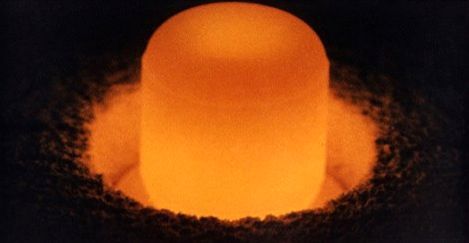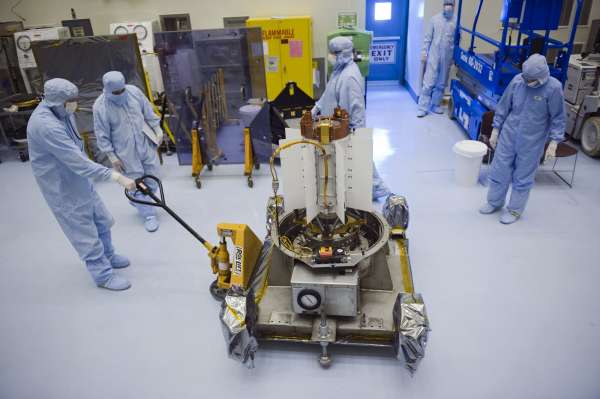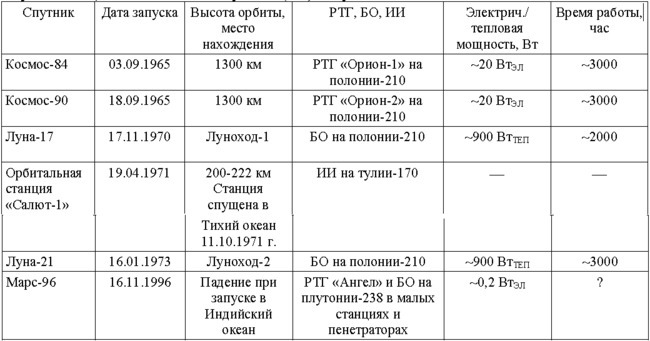NASA is experiencing an acute shortage of plutonium-238 for spacecraft power sources
NASA is experiencing an acute shortage of plutonium-238 for spacecraft power supplies. At this time, NASA has a stock of 35 kg of plutonium, of which only 17 kg correspond to the required quality for creating spacecraft power sources, which roughly corresponds to the three “atomic batteries” used in the Curiosity rover. The remaining 18 kg do not correspond to the required level of heat release for use in MMRTG (RTG).

The Pu-238 isotope has a spontaneous fission rate of 1.1x10 6 divisions / s * kg (specific radioactivity 17.5 curie / g - which is 2.6 times more Pu-240) and a very high thermal power: 567 W / kg. Strong neutron radiation and heat make it very inconvenient to handle and this limits its use mainly in power supplies. Pu-239 is used as weapons-grade plutonium.
The United States used RTGs with plutonium-238 on 24 spacecraft. Among the vehicles that "fed" plutonium-238, are the American "Voyagers", launched in 1977 to Jupiter and Saturn and have already reached the borders of the Solar System. Plutonium was also used in near-earth satellites and in the Apollo program. I had to use such a power source and the " Mars-96 " (270 g of plutonium for heating and powering the Russian rover).
')

Plutonium power sources are also used in other space vehicles for deep space research, where the use of solar batteries is difficult or impossible:
In the United States, plutonium-238 production was discontinued in 1988, and since then accumulated stocks have been used. In 1992, the United States signed a five-year contract for the purchase of an isotope from Russia in the amount of 10 kg and the possibility of increasing supplies to no more than 40 kg. The contract was extended several times until, in mid-December 2009, Russia notified the United States that it would not be able to supply 10 kg of plutonium-238 for spacecraft power sources in the next two years. Russia insisted on renewing the purchase agreement on new terms.
In 2009, a report was prepared by the National Research Council (NRC) recommending that production of plutonium-238 be resumed to avoid future delays or cancellation of future scientific missions.
Despite the relatively small amount of 75-150 million dollars needed to restore production, the difficult budget situation in the United States and the bureaucratic features of the American government mechanism buried for several years the start of work to restore isotope production. As usual in the USA, in such situations, interested individuals and organizations bring “dirty linen in public” to the public, calling for patriotic feelings and engaging politicians in lobbying:
In 2012, after several attempts, the Obama administration managed to smuggle through Congress funding to restore plutonium-238 production, provided that NASA paid for the repair of the outdated infrastructure at the Los Alamos National Laboratory in New Mexico. At the end of the repair, the Energy Department will start producing 1.5 kilograms of plutonium-238 per year. This will bring the remaining 18 kg of plutonium to the required level of heat release for use in MMRTG. Even if plutonium production does not immediately reach the planned 1.5 kg per year, there is enough plutonium stock for the next decade. So far, NASA is planning only one mission using plutonium - Mars 2020 , a project identical to the Curiosity rover. The plans for the remaining plutonium are still unknown. NASA needs to plan the expansion of the production of the required isotope and also revive the project in 2013, the Advanced Stirling Radioisotope Generator , which produces 140 watts using 4 times less plutonium than is necessary to obtain the same power using MMRTG.
Sources :
PS From Russian history : “Radionuclide thermoelectric generators (RTG) and heating blocks (BO) on polonium-210 and plutonium-238, gamma-radiation source (AI) on thulium-170”


The Pu-238 isotope has a spontaneous fission rate of 1.1x10 6 divisions / s * kg (specific radioactivity 17.5 curie / g - which is 2.6 times more Pu-240) and a very high thermal power: 567 W / kg. Strong neutron radiation and heat make it very inconvenient to handle and this limits its use mainly in power supplies. Pu-239 is used as weapons-grade plutonium.
The United States used RTGs with plutonium-238 on 24 spacecraft. Among the vehicles that "fed" plutonium-238, are the American "Voyagers", launched in 1977 to Jupiter and Saturn and have already reached the borders of the Solar System. Plutonium was also used in near-earth satellites and in the Apollo program. I had to use such a power source and the " Mars-96 " (270 g of plutonium for heating and powering the Russian rover).
')

Plutonium power sources are also used in other space vehicles for deep space research, where the use of solar batteries is difficult or impossible:
- The Galileo spacecraft orbiting Jupiter demanded 15.6 kg of plutonium-238.
- The Cassini spacecraft operating on Saturn’s orbit carries 32.7 kg of plutonium-238.
- The New Horizons spacecraft, currently flying to Pluto, has 10.9 kg of plutonium-238 on board.
- The rover "Curiosity" receives the necessary energy from 4.8 kg of plutonium-238
In the United States, plutonium-238 production was discontinued in 1988, and since then accumulated stocks have been used. In 1992, the United States signed a five-year contract for the purchase of an isotope from Russia in the amount of 10 kg and the possibility of increasing supplies to no more than 40 kg. The contract was extended several times until, in mid-December 2009, Russia notified the United States that it would not be able to supply 10 kg of plutonium-238 for spacecraft power sources in the next two years. Russia insisted on renewing the purchase agreement on new terms.
In 2009, a report was prepared by the National Research Council (NRC) recommending that production of plutonium-238 be resumed to avoid future delays or cancellation of future scientific missions.
Despite the relatively small amount of 75-150 million dollars needed to restore production, the difficult budget situation in the United States and the bureaucratic features of the American government mechanism buried for several years the start of work to restore isotope production. As usual in the USA, in such situations, interested individuals and organizations bring “dirty linen in public” to the public, calling for patriotic feelings and engaging politicians in lobbying:
“It would not be a big exaggeration to say that the future of the undisputed US leadership in planetary research in the 21st century depends on plutonium-238,” said Alan Stern, head of the New Horizons mission in an interview with Space.com. “We can still undertake one research mission after Curiosity, but that's all.” This is some kind of madness. It’s irresponsible to go so close to the edge of the abyss. ”
“I believe that in the subcommittee that controls the budget of the Ministry of Energy, there are people who are opposed to the resumption of plutonium-238 production,” Alan Stern told Space.com. - They have enough power to prevent this, which they have been doing quite effectively for a number of years. We need to turn to the Russians, to get to the orbital station, we can no longer explore the moon as in the times when I was a boy, and now also lose the ability to explore the solar system to its very limits. This weakens the United States and cannot cause anything but a feeling of deep disappointment. It is necessary to openly name the people who block the resumption of plutonium-238 production. These are anti-patriots. ”
In 2012, after several attempts, the Obama administration managed to smuggle through Congress funding to restore plutonium-238 production, provided that NASA paid for the repair of the outdated infrastructure at the Los Alamos National Laboratory in New Mexico. At the end of the repair, the Energy Department will start producing 1.5 kilograms of plutonium-238 per year. This will bring the remaining 18 kg of plutonium to the required level of heat release for use in MMRTG. Even if plutonium production does not immediately reach the planned 1.5 kg per year, there is enough plutonium stock for the next decade. So far, NASA is planning only one mission using plutonium - Mars 2020 , a project identical to the Curiosity rover. The plans for the remaining plutonium are still unknown. NASA needs to plan the expansion of the production of the required isotope and also revive the project in 2013, the Advanced Stirling Radioisotope Generator , which produces 140 watts using 4 times less plutonium than is necessary to obtain the same power using MMRTG.
Sources :
- Plutonium-238
- US Nuclear Stockpile Stockpile Good for Two More Nuclear Batteries after Mars 2020
- Plutonium
- Plutonium depletion of the US space program
- NASA CAN MAKE 3 MORE NUCLEAR BATTERIES, AND THAT'S IT
- WE HAVE ENDED NUCLEAR FUEL FOR SPACE TRAVEL - article found after publication, I recommend.
PS From Russian history : “Radionuclide thermoelectric generators (RTG) and heating blocks (BO) on polonium-210 and plutonium-238, gamma-radiation source (AI) on thulium-170”

Source: https://habr.com/ru/post/377333/
All Articles